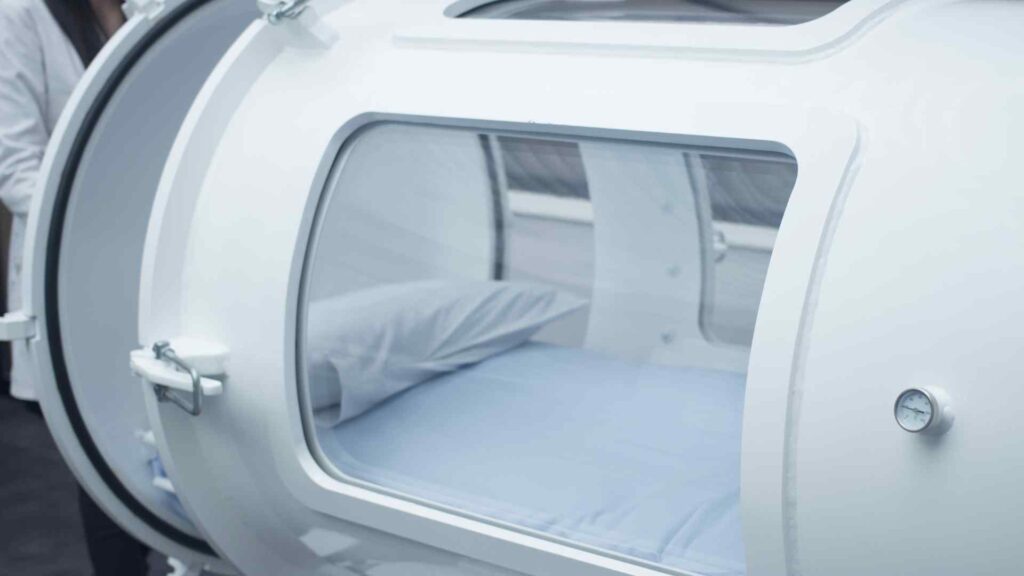Sudden sensorineural hearing loss can be a distressing experience, often prompting patients to seek every available treatment to restore their hearing. Hyperbaric oxygen therapy (HBOT) has emerged as a potential option, especially for those with severe or profound loss or those unresponsive to steroids.
In this article, we’ll examine the effectiveness of HBOT for sudden hearing loss, review the latest evidence from clinical studies and consensus guidelines, and discuss which patients are most likely to benefit.

Understanding Hyperbaric Oxygen Therapy
Hyperbaric oxygen therapy involves breathing pure oxygen at higher-than-normal air pressure within a specialized chamber. By increasing the oxygen supply beyond what would be possible at normal air pressure, HBOT delivers more oxygen to body tissues, including the delicate structures of the inner ear.
This extra oxygen can help reduce hypoxia, inflammation, and cellular injury in the cochlea, which is especially critical in patients experiencing sudden sensorineural hearing loss and tinnitus. The practice of hyperbaric oxygen treatment is generally administered in daily sessions over several days, with each session typically lasting from 60 to 90 minutes at pressures of 2.0 to 2.5 atmospheres absolute (ATA).
Types of Hearing Loss Treated with HBOT
The use of hyperbaric oxygen therapy is primarily focused on idiopathic sudden sensorineural hearing loss (SSNHL), that is, sudden deafness with no clearly identifiable cause. The therapy is also considered in cases where vascular compromise, autoimmune factors, or inner ear infections are suspected contributors. SSNHL is defined as a hearing loss of at least 30 decibels across three consecutive frequencies within 72 hours.
Patients with idiopathic sudden sensorineural hearing loss at a severe or profound level, or those who have not responded to initial steroid treatments, are commonly considered for this therapy as salvage treatment or adjuvant therapy.
Clinical Evidence and Effectiveness of HBOT
A growing body of evidence, including systematic reviews and meta-analyses, suggests the therapy is effective, particularly when started early after the onset of hearing loss. Randomized controlled trials and umbrella reviews report that patients with SSNHL who received the treatment in combination with systemic steroid therapy had greater hearing gain and a higher chance of complete hearing recovery when compared to patients on medical therapy alone.
For example, one report found that HBOT provided an additional mean hearing gain of about 10 decibels over standard therapy in patients with this condition, especially those with initial losses greater than 70 decibels. However, it has also been noted that while the improvements are statistically significant, the clinical significance—the translation to real-world functional hearing improvement—may be modest and most evident in severe cases or at lower frequency sounds.
Treatment Protocols and Considerations
The typical regimen for SSNHL consists of daily treatments (5–20 total sessions), each lasting 60 to 90 minutes at 2.0 to 2.5 ATA, often with concurrent systemic steroid therapy. Early intervention, ideally within 7 to 14 days of symptom onset, yields the best results, with diminishing returns the later therapy is started. Protocols may vary slightly depending on severity, patient age, and whether treatment is used as initial, adjuvant, or salvage therapy. Combining HBOT with corticosteroid therapy in patients with severe hearing loss is now recommended by several professional societies.

Patient Selection and Prognostic Factors
Not all patients will benefit equally from hyperbaric oxygen treatment. The greatest hearing improvement is seen in patients with severe to profound initial hearing loss, those treated within two weeks of onset, and younger individuals. Profound idiopathic sudden sensorineural hearing cases (>80 dB loss) are less likely to achieve complete hearing recovery, but still may experience meaningful hearing gain.
Contraindications for HBOT include certain lung or heart diseases, untreated pneumothorax, and pregnancy, and a thorough patient assessment is needed before starting therapy.
Safety, Risks, and Accessibility
While HBOT is generally considered safe, it carries risks, including middle ear or sinus barotrauma, transient vision changes, oxygen toxicity, and, rarely, more serious complications such as lung barotrauma. Availability of hyperbaric medicine centers and insurance coverage can also limit access to this therapy in some regions. Adherence to recommended protocols and selection criteria are essential to minimize complications.
Final Thoughts from Quantum Wellness Center
Hyperbaric oxygen therapy is a well-established, evidence-based treatment option for idiopathic sudden sensorineural hearing loss. While the hearing gains may not restore everyone to baseline, HBOT offers a valuable avenue for improving hearing outcomes in patients with acute, severe hearing loss when traditional therapies are insufficient.
At Quantum Wellness Center we provide advanced hyperbaric oxygen therapy designed to support hearing recovery and overall ear health. Our personalized HBOT treatments in Orem, UT and Sarasota, FL aim to enhance oxygen delivery to the inner ear, promoting healing for patients experiencing sudden sensorineural hearing loss. Discover how hyperbaric oxygen therapy can be a key part of your journey to improved hearing and wellness with our expert care and luxurious, state-of-the-art facility.



